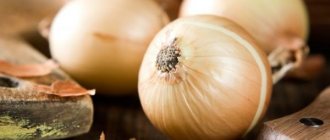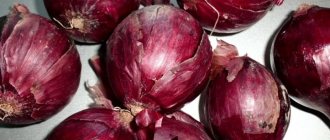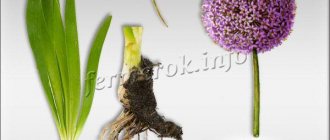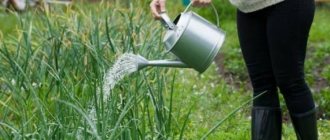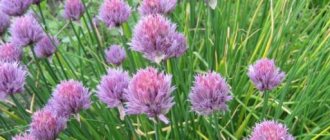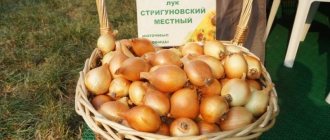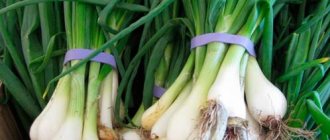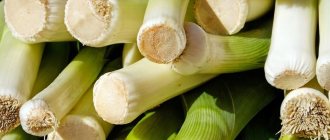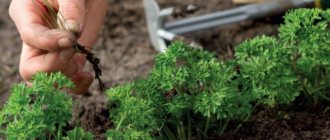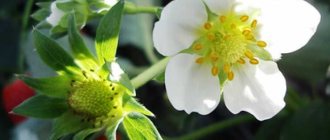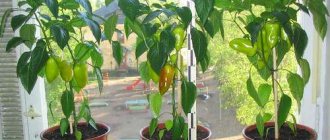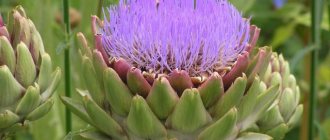The best predecessors before planting onions
The best predecessors for onions are:
- zucchini;
- green manure;
- beans;
- beans;
- peas;
- early potatoes;
- cucumbers;
- pumpkin;
- cabbage.
After these plants, the onion will not only grow quickly, but will also delight you with a good harvest.
Also, favorable soil is considered to be one in which organic fertilizers were applied in large quantities before planting. After planting and during the growing season, organic matter is not added to the onion beds, as this harms the plant.
Winter sets are planted after corn, tomatoes, lettuce and cucumbers. A cold-resistant crop will sprout at an air temperature of +5…+7℃. But do not forget that the lower the temperature, the later the shoots will appear.
Tips and recommendations from experienced gardeners
Onions are not that difficult to grow without using store-bought fertilizers and pesticides. To do this, you need to strictly observe fruit change and take care of the fertility of the land. By planting onion plants after cabbage or cruciferous green manure, we ensure the supply of sulfur. Wood ash neutralizes slight soil acidity. The best organic matter for onions is rotted bird droppings, which are richer in phosphorus and nitrogen than manure. It is introduced in the form of humus under the previous crop.
Previous OnionHow to properly deal with powdery mildew on onions Next OnionWhy do onions turn yellow and what to do about it
Timing and rules for planting before winter
Before planting in the fall, planting material is sorted and sorted. Specimens with signs of disease, rot, or mechanical damage are removed.
Selected sets are sorted by size into three groups: bulbs up to 1 cm in diameter (oat), from 1 to 3 cm in diameter (sets) and more than 3 cm in diameter (selection). Seeds from the first and second groups are planted for growing bulbs; the selection is well suited for planting on greens.
The planting bed is chosen in a well-lit place
It is important that rainwater and moisture do not stagnate on it after the snow melts
To protect against diseases and pests, the soil is disinfected with a solution of copper sulfate (1 tbsp per 10 liters of water). Water at the rate of 2 liters per 1 sq. m.
Then fertilizers are applied. For each square meter use 3-4 kg of humus, 5 kg of peat, 2 tbsp. l. superphosphate. The earth is being dug up.
The finished beds are leveled and compacted. Furrows 5 cm deep are cut on the surface of the earth at a distance of 15 cm from each other. The seedlings are laid out in furrows at a distance of 3-4 cm from each other and sprinkled with a mixture of peat and humus.
Landing dates
On average, winter onions are planted from October 5 to October 30. When determining the timing, they are guided by the climate of the region and the weather. As soon as the outside temperature drops to +5...+7°C and remains at this level for a week, planting begins.
If the weather is unstable, the sowing can be divided into two parts. Plant one in mid-October, the second at the end. There is no point in planting after the onset of frost - the onions will freeze and will not sprout in the spring.
To protect crops from freezing, before frost, the bed is mulched with peat in a layer of up to 2-3 cm. In spring, the mulch is removed so that the soil warms up faster. If in winter the temperature drops below -10°C, the soil is additionally covered with snow.
Plant care rules
Shoots will appear in the beds after a week. Onions require abundant watering, mandatory weeding, shallow loosening, and protection from insect pests.
Watering and fertilizing onions
Abundant moisture is especially important in the first 3 months of onion development. With insufficient watering and fertilization, small and tasteless bulbs are formed.
Scheme for moistening the beds:
- during the first month, water once a week to a depth of 10 cm;
- in June, when the turnips are growing, the ground is moistened once every 10 days by 20-30 cm;
- in early July, water as the top soil layer dries;
- at the end of July, only “dry watering” is used - the top soil crust is broken to reduce moisture evaporation;
- 3 weeks before harvest, work on the beds is stopped and the “shoulders” of the turnips are freed from the ground.
Secrets of safe watering of onions:
- water is poured without pressure so that the feathers do not break;
- use lukewarm liquid (from +20°C), since cold watering increases the likelihood of onions being damaged by a fungal infection;
- If the rules of moistening are not followed, the neck does not dry out, which negatively affects the keeping quality of turnips.
In order for large and juicy bulbs to form, the plant must receive a sufficient amount of nutrients. Feed turnips several times a season:
- 2-3 weeks after the sprouts appear. Dissolve a tablespoon of urea or ammonium nitrate in a 10-liter bucket of water. Pour at the root, the specified amount is consumed per 10 m2.
- In mid-June. For 10 liters of water take 20 g of superphosphate, 10 g of potassium sulfate. They pour at the root. Additionally, you can feed onions using the foliar method. Use boron preparations and ash infusion (0.5 liters per 10 liter bucket of water).
- The onions are fed a third time if the development of the turnips has slowed down. 40 g of superphosphate is dissolved in 10 liters of liquid. 5 liters of product are used per 1 m2.
After fertilizing the onions, the soil must be moistened.
Weeding the onion bed
It is extremely important to keep the soil in the area free of weeds. Weeds take away nutrients from developing turnips, and also, by increasing the level of soil moisture, provoke the appearance of a fungal infection
If you grow onions in waterlogged beds overgrown with weeds, the neck will become too juicy, which will negatively affect the safety of the crop.
Weeding is carried out when the weeds grow to 4-6 cm. It is better to clean the beds after watering or precipitation, so that the roots are easier to pull out of the ground.
Loosening and mulching the beds
Mulch is required. The soil crust that appears after watering prevents the onion roots from evenly receiving a portion of moisture. Due to alternating waterlogging and drying out, turnips turn out small.
They loosen shallowly. And only between the rows. Do not touch the soil under the onions, otherwise you can injure weak, superficial roots.
Hilling up the crop is unacceptable. In order for turnips to grow well, their “shoulders” must be illuminated by the sun.
Next to what does a crop grow best in open ground?
It's hard to find ideal neighbors; you always have to put up with something.
Onions are often placed between rows:
- beets;
- salad;
- cucumbers;
- strawberries;
- spinach
This is because it has a fibrous shallow root system that absorbs nutrients from the top layers of soil. And its neighbors are plants with long taproots. And they get their food from the depths. That is, no one takes food from anyone.
Carrots, tomatoes, cabbage, and potatoes will not shade onions while they are growing their leaf mass.
Attention! By placing onions and garlic next to cucumbers, you can protect them from bacteriosis.
| Good neighbors | Pros of the neighborhood | Disadvantages of the neighborhood |
| Carrot | They protect each other from insects. | Sets, unlike seeds, are best planted 1-2 rows from carrots, otherwise the yield will be lower than with single planting. |
| Tomatoes | They produce useful fungicides and have a similar drinking regimen. | Plant onions on greens, because... due to lack of light, the tubers will not develop. |
| Cabbage | Like onions, cabbage needs regular watering at first. | Plant onions only on greens, otherwise the cabbage leaves will shade and prevent the tubers from developing. |
| Potato | For potatoes, the proximity of onions is very useful - it repels the Colorado potato beetle. | For onions, the proximity to potatoes is indifferent, as long as they do not end up in the shade. |
| Beet | Substances secreted by beet roots have a beneficial effect on onions. | Dense beet foliage will not add to the yield of onions. Can be planted on a feather. |
| Pepper | Different levels of nutrients in the soil, identical growing conditions. | Plant between rows so that the peppers do not shade the onions. |
| Salad | ||
| Spinach | If the bow is on the feather. | |
| Radish | Onions protect radishes from pests. | Bow on feather. |
| Parsley | Takes up little nitrogen. | |
| Strawberries | Onions protect the berry garden from diseases and pests. They do not interfere with each other when consuming nutrients from the soil. Perennial onions are especially good - in the same cycle with the berry plant for 4-5 years. | Plant so that the onions have enough light. |
| Chamomile | Chamomile phytoncides protect onions. | Plant chamomile rarely so as not to shade it. |
| Dill | Dill improves the taste of onions. | Plant onions on feathers. |
Other features of crop rotation
You can plant winter onions in the beds where the crop grew in summer if there are no other options. But only if it grew in one place for no more than two years. This point should be calculated - if, for example, in the fall of 2021, onions were first planted in the garden bed before winter and grew continuously there in the future, in the fall of 2021 you need to find another place. In this case, it will be possible to replant onions there only after 4 years. This is also true for other plants of the Allium family: garlic, wild garlic, chives, leeks and other species.
Crops belonging to the Onion family have the same pests and need the same soil microelements, so they should not be grown in one place for too long
The rules of crop rotation are associated with soil depletion, because each crop takes certain substances from the ground. Also of great importance are pests that breed in large numbers next to specific plants, depending on their “specialization.”
Carrots are a good choice as a neighbor to winter onions; they can also be planted before winter.
Following the rules of crop rotation for winter onions will help you get a high-quality harvest next year and protect the plant from diseases and pests.
What crops can be planted after onions?
When choosing what can be planted in the garden after onions, take into account the remainder of mineral fertilizers that were left unused last season. In addition, the soil is slightly alkaline, which is why vegetables are selected for which such conditions will be ideal. These include:
- Strawberry. This plant will feel comfortable in the garden after the onions. In addition, substances that can disinfect the soil remain in the soil. This way, the strawberries will grow healthy and produce a good harvest;
- Beets and carrots. They will grow well in the area where onions grew. Root crops will grow large if their neighbors are tomatoes, spinach, and peas;
- Tomatoes and cucumbers. These plants will bear a large number of fruits, which will delight the gardener. In addition, these cultures do not resist other predecessors. The only thing that needs to be done is to revive the soil before planting;
- Cabbage and pumpkin. These crops will sprout quickly and begin to actively develop in the bed where the onions grew. In addition, these plants will not need additional food, since the fertilizers that were applied to the onions will be enough for them.
If the question arises of what to plant in place of onions, which belong to early varieties, then in this case you need to choose early crops as a replacement. It can be:
- peas;
- black Eyed Peas;
- early variety of carrots;
- beets of early varieties;
- radish;
- ultra-ripe cabbage.
These crops will delight the gardener with generous harvests already at the end of September. In August, as soon as the onions are harvested, you can sow greens or radishes. Their seeds will quickly sprout and begin to grow and develop. By October, a new set of fresh, juicy vegetables with a full range of vitamins and minerals so necessary for the human body will appear on the table.
Sewing change for onions
For spring crop rotation, you also need to know after which you can plant onions in the spring. After all, in order for it to produce a good harvest, it needs to create comfortable conditions. Before planting this plant, you should take into account the fact that onions need to grow on the sunny side of the site. In addition, its growth requires minerals such as phosphorus and magnesium. These substances remain in the ground after crops such as:
This is explained by the fact that when growing all these crops, mineral fertilizers are added to the soil, which are not used up during the growth process. Therefore, the onion receives all the essential microelements it needs to grow. Experts created a table in which they indicated in different colors what, when and after what should be sown in open ground.
Advice. To get a double harvest from one bed, you need to plant onions after harvesting early varieties of potatoes. This is done in July. Thus, harvests of two crops will be obtained from one bed per season.
Experienced experts give their recommendations, after which it is better to plant onions. After conducting a series of experiments, they came to the conclusion that this crop produces an excellent harvest if the predecessors were legumes, grains or herbs, vegetables for which fertilizers are applied, such as potatoes or cabbage.
Not suitable for sowing
In addition, grain crops provide double benefits. First of all, they saturate the soil with essential minerals, and secondly, they act as allelopaths. That is, when growing cereals on the site, the number of weeds is significantly reduced. Barley and rye are not suitable for restoring soil for onion plants.
Important! Onions develop well after clover and buckwheat. But it is recommended not to grow them until they are ripe, but to plow them into the ground
Thus, the soil will be enriched and loosened. In spring you can already plant onions. After such manipulations in the fall, you can get a generous harvest.
Good neighbors
If your dacha plot is small, but you want to plant different vegetables, combined planting is used. Thus, the summer resident does not leave a single piece of land empty. In this case, you can collect several harvests with one hundredth. In this case, you must follow all the recommendations of specialists. Most often, gardeners combine crops such as onions, radishes, parsley and carrots.
They do it as follows. Onion sets should be planted in the garden bed, but the distance between the bulbs should be at least ten centimeters. Radishes are sown between them. Then you can sow carrots and parsley between the rows. According to the harvest time, each plant has additional time for growth and development. First of all, radishes are removed from the garden, after which comes the turn of onions. And when carrots and parsley remain in the garden bed, they have enough space for growth and development.
Important! It is recommended to sow perennial onions and leeks at a distance from onions
Features of good cultivation of winter onions, how to plant
The benefits of onion are invaluable, and the plant is considered to be quite cold-resistant, its seeds can begin to germinate as early as 5-7 degrees, but it should be taken into account that the lower the temperature, the later the first shoots will appear. Therefore, if you take your time and wait for the air to warm up from about +16 to +20 degrees, then the first shoots can be obtained in 6-8 days. It is noteworthy that sharp onion varieties are much less susceptible to frost.
The optimal temperature for onions is 22-25 degrees.
Soil composition for planting
The most optimal soil for planting onions is chernozem soils, but even they need to add a certain amount of fertilizer. Read how to feed onions here. Provided proper care, peat bogs and loams are also suitable. If you do not fertilize loamy soil, then the crop grown on such soils will be tasteless, unsustainable, and even begin to rot during storage.
Sandy soils are completely unsuitable for planting onions, both seedlings and seeds. Read how to grow onions from seeds here. Onions are not a very moisture-loving plant, so excess moisture must erode and evaporate, which means the area for onions must be sufficiently open to sunlight and wind. In order to obtain a good harvest, the soil in the onion beds must be prepared in the fall. To do this, first of all, it is necessary to carefully dig up or plow the soil and remove all the plants remaining there. There is no need to level the surface of the earth; in this case, various harmful microorganisms remaining in the soil will be able to freeze out. In the autumn, humus and phosphorus-potassium fertilizers can be applied as fertilizers. In winter, the soil seems to absorb nutrients, and in the spring, with active snowmelt, they fall deep inside, which will be very useful for the future plant.
Read about processing onions before planting at the link.
Even the slightest excess of acidity pH values of 6-7 units causes great harm to the development of the bulbs: the leaves become smaller and turn yellow. If the acidity of the soil in the onion plot is high, it is recommended to lime it.
After liming, it is recommended to grow onions in this area no earlier than after 2-3 years.
Also in the spring you can add 60 g of superphosphate, 10 g of urea and 20 g of potassium chloride to the soil, all this per 1 square meter. m You don’t have to apply fertilizers deep into the soil, but simply rake them along with the soil.
During the period of active plant growth, about 2-3 weeks after planting the onions, it is necessary to fertilize the soil with some organic fertilizer, for example, chicken manure diluted with water in a ratio of 1:12. Another good option is to prepare an ammonia solution. For 10 liters of water, take 30 g of ammonium nitrate. During the formation of the bulb, this composition is very effective: 30 superphosphates are taken per 10 liters of water.
Soil condition after onions
Everyone knows that for good growth of a crop, a complex of certain minerals is necessary. Onions are no exception. If it is replanted in one area for several years, the soil will lose a large amount of minerals, and, accordingly, the plant will not grow large and healthy.
There is another reason why planting onions in the same place is impossible - these are pests and their larvae that remain in the soil and live there and wait for food. The same situation applies to diseases whose pathogens do not disappear. For example, we can cite late blight, which affects some vegetables. Its bacteria stay in the soil for a long time and can infect any plant that is sensitive to it.
Note. In addition, vegetables release substances that, in fact, help the vegetables that replace them grow.
It is worth remembering celery, which repels pests that attack cabbage. Wheatgrass growing on the site is destroyed with the help of rye.
Selecting a successor, what can be planted after the onions, is a very important stage in gardening. A suitable replacement will give the soil a chance to rest and accumulate the minerals that were used. In the process of selecting a “replacement”, it is necessary to take into account which minerals will help the plant grow and develop. They must be different and located at a different soil level from the previous ones. To make it easier to coordinate the sowing process, it is recommended to keep a notebook where the sowing changes of previous years will be kept records.
When choosing vegetables that can be planted after onions, and other plants, you must follow the following rules:
- Plants belonging to the same species should not be planted nearby, otherwise the plants may be damaged by both bacteria and insects in the soil;
- It is necessary to refrain from sowing early-ripening vegetables after late-ripening varieties. Depleted soil does not have the opportunity to accumulate useful substances;
- It is not recommended to sow plants in the same area that require the same minerals for growth;
- Having collected vegetables of one crop, you need to immediately sow the seeds of a plant that can restore the mineral balance of the soil.
Interesting to know. After the onion harvest, you don’t have to wait for the sowing cycle to end. There are crops whose ripening period is very short, so they are sown immediately after harvesting the predecessor.
Why is crop rotation important?
If you plant the same crop in one place for several years in a row or alternate it with unsuitable vegetables, the soil is depleted and harvests become poor.
In addition, diseases and pests characteristic of a particular plant accumulate in the soil and affect annual plantings with greater force. This also leads to a decrease in yield. Help Each plant needs more certain elements, which it actively takes from the soil. As a result, the soil becomes depleted, and every year the crop grows worse and worse.
Also, the roots of some plants secrete substances that can inhibit the growth of others. Many crops are sensitive to their own root secretions, for example, spinach, beets.
Knowledge of good and bad predecessors, as well as the optimal proximity of vegetables, allows you to prevent these problems. Compliance with the principles of crop rotation is necessary to maintain the quality of the soil and increase productivity.
Experienced and practical gardeners draw up on paper a schematic site plan for several seasons in advance, indicating the planting locations for the vegetables they grow. One of the basic rules is not to alternate plants belonging to the same family in the garden. Next, we will look at the basics of crop rotation as applied to onion vegetables.
What can you plant after potatoes next year?
Potatoes are considered a good predecessor for many garden and vegetable plants. This is due, among other things, to her eating habits. When planting potatoes, they often add not even humus, but almost fresh manure, since they are fine with this. Over the course of a season, the manure in the bed naturally completely rots, almost without losing volatile nitrogen compounds. Potato bushes consume some of the nutrients, but a fair amount of them, in a form accessible to plants, remains in the soil. Therefore, next year it is enough to just slightly correct the condition of the soil by introducing certain mineral fertilizers, depending on the preferences of the crop chosen for this bed.
Potatoes do not extract very many nutrients from the soil and do not deplete it
In addition, potato bushes are so strong that they suppress the development of most weeds, and the soil remains fairly clean. Not too many toxic substances remain after potatoes. True, it attracts the Colorado potato beetle, and any vegetables affected by this pest have no place next year in the area where potatoes were grown. However, there are few such crops, and almost everything grows well after potatoes. You can plant next year in this place:
- any root vegetables (for example, radishes, carrots, beets);
- various “green” crops (salads, mustard greens, hyssop, etc.);
- onions, garlic (these bulbs are famous for the fact that they themselves disinfect the soil well);
- any types of cabbage (white and red, cauliflower, savoy, kohlrabi, etc.);
- cucumbers and generally any pumpkin crops (zucchini, squash, pumpkins);
- legumes (beans, lentils, peas): they saturate the soil well with nitrogen compounds.
Before planting root crops, the former potato bed can be hardly fertilized
Dill and parsley also grow normally in former potato beds, but it’s even better if you plant them in this place a year later.
It is best, of course, if you have time and space, to sow any green manure after the potatoes - herbs that are mowed before flowering. These are, for example, lupine, oats, mustard, etc. Green manures restore the soil well. If the potatoes were harvested early, then the herbs can be sowed this year, then the soil will be in ideal condition by the new season.
Types and varieties of onions
The species and varietal composition of onions is very diverse. They differ in the time of cultivation, the structure of their green and underground parts. Smell and taste may vary significantly. Any gardener can choose a variety according to his taste preferences. Unfortunately, not all types of onions are widely used. The existence of some is known only by hearsay.
Bulb onions
This type of plant is familiar to everyone. The underground part, the onion, is eaten. Green feathers are tough, and cutting them off en masse during the growing season can negatively affect the harvest.
It is grown from seeds - nigella, or by planting sets.
Leek
Its second name is pearl. Grown to produce a stem - legs. It has a fleshy structure and a delicate taste. During storage, the vitamin C content does not decrease. The leaves of the plant are ribbon-shaped. The place of the bulb develops a bake. Its length can reach from 15 to 40 cm with a thickness of up to 8 cm.
Seeds of this species lose their viability after two years. This is worth considering when purchasing.
Famous varieties: Jolant, Karantansky, Bandit, Detri, Ginka, Vesta, Goliath, Tango.
Shallot
It is found under the names of multi-stellar or family onions. You can often hear the name “kushchevka”. The peculiarity of the structure is the formation of a nest from one planted bulb, which can contain up to 10 bulbs. Their size, however, is small - up to 3.5 cm in diameter.
This type of onion actively accumulates nitrates, so it is advisable to fertilize it with organic fertilizers.
Varieties: Kuban yellow, Zvezdochka, Russian violet, Siberian yellow, Bonilla.
Chives
There are its names: rezanets, skoroda, rezun. Rich in vitamins.
Designed for growing on greens. High sugar content gives a sweet taste. Very frost-resistant, suitable for growing in northern regions. They are grown for 3–4 years in one place; in the 4th year of cultivation it produces up to 150 branches in one bush. Cutting is carried out 2–3 times per season. Propagated by sowing seeds or dividing the bush after 2–3 years of cultivation.
Popular varieties: Moscow early ripening, Siberian, Bohemia.
fragrant onion
This species, often called Japanese, has flat leaves that are rounded at the tips. It grows in one place for 4–5 years. By this time, it forms up to 25 branches simultaneously. Contains a lot of carotene and ascorbic acid. The false bulb has a diameter of up to 1.3 cm. It blooms with beautiful white inflorescences about 5 cm in diameter. Propagated by seeds or vegetatively, dividing a 2-3 year old bush.
Fragrant onions are zoned for different climatic zones; Dzhusay and Fragrant are popular.
Multi-tiered bow
Common names: Egyptian, Pocambolo. During the growing season, it forms 2–3 tiers of aerial bulbs. The plants are cold-resistant, greenery grows in March. It reproduces by the same aerial bulbs. Planting material is collected immediately after ripening - the bulbs on the plant quickly deteriorate.
Famous varieties: Odessky, Gribovsky 38, Likova, Pamyat.
Onion
Often called sandy or tartar onion. Biennial plant. Instead of a bulb, it forms a thickening of the stem. Cultivated for feathers. In the second year the plant blooms. It can grow in one place for up to 4 years.
Aging Bow
Wild onions - puchhu, mangyr, wild onion. Distributed in Mongolia, Korea, and the Caucasus. The leaves are flat. As the plant matures, it acquires a pungent taste. The bulbs are cut into rings and dried. Used in first courses.
Slime Bow
This type of onion has flat, juicy and tender leaves. The taste is not spicy with a slight aftertaste of garlic. Propagated by seeds or through seedlings.
Alrat. Albert, Star, Cascade.
Cheremsha
The plant is classified as garlic due to its distinct odor. In fact, this is also an onion; the name “bearish” is found. Unlike garlic, no smell remains after eating. The leaves are used fresh, pickled or salted in winter.
The names of some varieties come from the name bear: Bear cub, Bear delicacy, Bear ear.
Ramson does not grow well in sunny places. The best place for it is partial shade.
How does crop rotation occur in the field?
The only thing we know about growing bulbs in an open field is that it is a troublesome business. However, there are such craftsmen who are not afraid of difficulties and soon, onions begin to appear on the field. Careful care of the plants leads to the fact that in the fall the crop is harvested and the field is plowed. Further actions depend on the owner; if he wants to plant carrots in an open area, then use a cultivator to cut the ridges, plant winter carrots and cover with mulch. If the next planting is intended for beets, then after plowing, the area is leveled and left untouched until spring. In early spring, beet seeds are sown.
Seed preparation
Regardless of whether the seeds are sown to obtain seedlings or directly into the ground, several agrotechnical measures need to be carried out:
Quality checking. The need for this operation is caused by poor germination of seeds; if it is insufficient, to obtain even germination during sowing it is necessary to increase the planting density.
To check, the seeds are wrapped in a damp cloth and left for a period of 10 to 20 days, periodically moistening. There are no special temperature conditions for this - onion seeds germinate at temperatures from +2 degrees Celsius. If less than 75% of the seeds have germinated, increase the planting rate;
Spores of fungal diseases are destroyed by soaking the seeds in a pink solution of potassium permanganate. Treating time is 10 - 12 hours immediately before sowing;
Before planting, the seeds are dried - when wet, it is difficult to distribute them evenly over the surface.
Planting green manure after harvesting onions
If mid-season or late-season onions were grown at the dacha, harvesting can begin at the end of August or beginning of September. The period of night frosts will soon begin, so it will not be possible to plant a new crop after the onions are harvested. To saturate the soil with useful substances and establish crop rotation, you can use green manure, which in everyday life is called “green doctors”. Their planting will allow:
- prevent weeds from appearing;
- fertilize the soil;
- fight pest larvae and pathogenic bacteria, which in turn will ensure cleansing and disinfection of the soil;
- carry out good loosening of the soil due to strong roots.
For each site you need to select a specific green manure. This plant is classified into 5 varieties. The cruciferous family saturates the soil with phosphorus, sulfur, and organic matter, and protects plant crops from wireworms, root rot, and nematodes.
The Asteraceae family is a source of complex, difficult to decompose organic fibers. Cereals will help fill the soil with potassium, nitrogen and organic matter. Buckwheat will saturate the soil with the same microelements as cereals.
Important! When choosing green manure for onions, special attention should be paid to the cabbage family
How to properly create combined beds
Compliance with the rules of crop rotation, the correct selection of planting sites and neighbors will help to grow a good harvest of any vegetable crops. At the same time, their taste will be high, as will the content of nutrients. Some vegetable growers propagate onions by seed. Planting seeds in the soil can be done in late autumn or early spring, in a greenhouse or greenhouse. Only fully matured seedlings are planted in beds.
Most vegetable growers prefer to grow onions using a combined method. When planting seed material on a ridge, they alternate it with planting other vegetable and flower crops. It can be parsley, carrots, radishes or flowers (marigolds).
In addition, vegetable growers very often use tomatoes, watercress, and chives as neighbors of onions in the garden. This helps to increase the yield of all vegetable crops grown in one bed.
Combined ridges are created as follows:
- The optimal distance between rows of seedlings on ridges should be at least 20 centimeters.
- Planting is carried out in this way: a row of onions in which they alternate with radishes.
- Next comes three rows of carrots, two rows of parsley.
- Then follows again a row of onions with radishes.
The optimal width of the ridges should be at least one meter, height no more than 15 centimeters. This method of growing onions is the most optimal and allows you to protect the plantings from pests.
Predecessors of the bow
We have already found out what to plant after onions, and now let’s talk about what can be planted after onions so that there is a good fruit yield, and after which it is strictly forbidden to plant onions. First of all, it’s probably worth saying that the soil should be on the sunny side and not covered by shadow, it should be full of nutrients, namely potassium and phosphorus. Therefore, the best predecessors after which to plant onions are peas, pumpkin, tomato, cabbage and green manure. Typically, onion planting begins in late April or early May, but if you want to sow in July, the best place for seedlings will be in the bed after harvesting the early potatoes. Substances left in the ground after vegetable crops such as carrots, cucumbers, garlic and onions can have a negative impact on turnips.
Good company for onions would be neighboring beds with lettuce, radishes, beets, strawberries, spinach, carrots and cabbage. But it is not advisable to plant turnips next to beans, peas and beans, because they adversely affect the composition and growth of the vegetable. By the way, proximity to sage and chamomile also negatively affects onions.
Is it possible to plant onions next to garlic? This question often interests beginning gardeners. No one can give a definite answer. Some believe that the garlic smell serves as protection for the bulbs and drives away the onion fly and weevils from turnips. Others argue that such proximity has a detrimental effect on the bulbs, because the garlic crop feeds on the same substances as the bulbs, so there is a lack of fertilizer, which leads to early yellowing of the feathers and small fruits.
Crop rotation table: successors and predecessors of vegetables when planting
Crop rotation table: successors and predecessors of vegetables when planting (2.5 Mb)
As can be seen from this summary table of crop rotation, there are the best predecessors of vegetable crops, acceptable and bad:
— The best predecessors of tomatoes
- cauliflower and early cabbage, cucumbers, zucchini, pumpkins, greens, carrots and green manure. It is permissible to plant tomatoes after onions, garlic, herbs, beets, late and medium-sized cabbage. After other crops, it is no longer worth planting tomatoes in the garden.
— Wonderful predecessors of cabbage
– cucumber, zucchini, pumpkin and legumes. But then comes the division. For late and medium varieties, early potatoes and carrots are good, and for early and cauliflower it is better to sow after green manure and onions and garlic.
— Good predecessors of onions and garlic
(which you do not grow for greens) - cauliflower and early cabbage, cucumbers, zucchini, pumpkins, early potatoes, peas, beans, beans and green manure.
— The best predecessors of cucumbers, zucchini, pumpkin
etc. - onions, garlic, legumes, corn, early and cauliflower.
— Good predecessors of peas
– any cabbage, early potatoes, cucumbers, zucchini, pumpkins and squash.
— Excellent predecessors of carrots
– cabbage, potatoes, herbs and spices, cucumbers, zucchini and green manure.
— The best predecessors of pepper and eggplant
– cucumbers, onions, carrots, green manure, etc.
— Good predecessors of beets
– spices and herbs, potatoes, cucumbers, etc.
— Wonderful predecessors of potatoes
– zucchini, garlic, legumes, green manure, etc.
It seems that you managed to figure out how the table works without much difficulty. So, the “hurries” leave us, and we move on.
Soil fatigue: causes
Each vegetable feeds on the same substances; if they are constantly planted in last year’s place, this will lead to depletion of the soil. Consequently, in a couple of years the area will become unsuitable for growing other crops due to the lack of any minerals. Even applying fertilizers in one season will not correct the situation, since depleted soil very slowly replenishes its reserves and can only restore vitality after two to three years.
In addition, when planting a plant in the same place, pathogenic bacteria and pest larvae that specialize in this vegetable begin to accumulate in the soil. They are capable of infecting a garden bed and remaining in it for several years in a row. Naturally, the source of fire will not have the best effect on the planted vegetables, which will lead to the instant death of the root system and fruits.
There is also a risk of allelopathy in plants, because in the soil there are thousands of root systems that constantly interact with each other. Each root is endowed with certain chemicals, and for one type of plant this “neighborhood” has a beneficial effect on crop growth, while another type begins to die. For example, if you plant cabbage next to celery, the latter vegetable will protect the heads of cabbage from whites.
Compatibility of onions with other vegetables
Crop rotation in the garden is the alternation of different crops on plots. The main goal is maximum productivity of the site.
The planting plan is based on the following factors:
- Definition of leading culture. Here they determine which vegetable is a priority and how many bushes the gardener expects;
- Relief of the vegetable garden. For example, there is an abundance of water on the lower slopes. Strawberries and cucumbers love this soil;
- Predecessors. Different plants need different nutrients. In addition, some vegetables have a weak root system and take everything they need from the upper layers of the soil;
- Climate features;
- The degree of soil erosion on the site.
What can you plant next to onions? To answer this question, you need to know about some of the features of this vegetable. Its roots are very weak and thin, similar to cobwebs. They dry out quickly in the sun. Most of the root system is located in the upper layers of the soil. It grows into the ground no more than 50 cm.
In addition, the plant is very fond of nitrogen substances. Zucchini, pumpkin, tomatoes, cucumbers, peppers and various types of cabbage are also not indifferent to them. These vegetables completely select the substances beneficial to onions, so onions should not be planted after them.
Important! By following the rules of crop rotation, you can increase the yield of most vegetable crops several times.
What can you plant after onions in August?
Onions grow in potassium-rich soil. Such fertilizers must be added to each site owner when growing this crop. However, potassium-rich soil is not always suitable for other crops. Moreover, planting onions in one place year after year is also wrong. This can lead to soil depletion. Therefore, there will inevitably be a decrease in yield.
There is such a thing as soil fatigue. It is caused by the content of a certain set of mineral elements in the soil. They accumulate due to the cultivation of the same crop. The same is true for onions.
In order to avoid soil fatigue, after harvesting the onions in August, you should plant some other crops in the vacant space. They will avoid soil depletion and improve its quality for sowing other plants next year.
These plants should be listed in more detail:
- Chinese cabbage. It allows the soil to “rest”, preserves its ability to produce high yields and saturate plants with useful elements;
- Lettuce is a neutral crop. Spinach has similar qualities. Therefore, these plants are recommended for planting after the August harvest of onions. Compliance with this rule will make it possible to preserve soil fertility;
- If onions were harvested in September or late August, radishes may be planted after that. Even if the harvesting took place in August, you need to give the bed a little rest and sow it with radishes in September. Former onion beds sown with radishes produce excellent yields.
It should be separately noted that it is not worth leaving the bed unclaimed after harvesting the onions. First of all, an unseeded bed will suffer from exposure to sunlight. In addition, the soil structure will be disrupted due to the lack of a root system. Therefore, if there is no need to sow lettuce, Chinese cabbage or radishes, then it is recommended to sow annual flowers. But the best option would be green manure. These are special plants that improve the condition of the soil and prepare it for sowing other useful crops for the next year.
In addition, after harvesting the onions, you should fertilize the soil with nitrogen and peat. This will also create excellent conditions for high yields for the next agricultural cycle.
Characteristics and methods of growing crops
Onions are a biennial crop. In the first year it develops a bulb, which in the second year grows into a flowering plant that produces seeds.
Well-dried bulbs are stored well for several months at a temperature of about +20˚C and a humidity of 50-70%.
Turnips are grown in three ways: vegetatively, as an annual and biennial crop.
How to grow an annual
Large heads grow from seedlings already in the first year. This method is used infrequently, because growing and planting seedlings takes a lot of time and effort. But we must admit that these labor costs pay off with a high yield of large bulbs.
Such early varieties and hybrids as Stuttgarter Riesen, Yukont, Carmen, Snowball are suitable for annual cultivation.
How to raise a biennial
In the first year, seeds are sown and onion sets are grown. In the second year it is used as planting material. Mid- and late-ripening varieties are grown through seeding. For example, Setton, Aleko, Farmer Late, Slava Ozharova.
Vegetative propagation
Vegetative propagation is sowing with small bulbs. In this way, northern varieties of the crop are mainly grown, forming a nest of 10-20 bulbs.
Local varieties of the region, for example, Kirov, Pskov, Novgorod regions, are suitable for the vegetative method. Such onions are planted simultaneously with the sets or a little later (before the end of May).
Important! Planting in the fall is good because the plants are less susceptible to onion fly invasion. By the time the fly is ready to lay eggs, the heads will have already formed a dense bottom and a developed root lobe. This will make it more difficult for the hatched larvae to penetrate the heads.
Predecessors are the crops that occupied the garden bed last year. Onions are not planted in one place for more than 2-3 years in a row. After what to plant onions next year? The best predecessors for it are considered to be those crops for which large amounts of organic fertilizers were applied.
When choosing a place for planting, it is worth considering that turnip onions do not like heavy clay soils. The soil should be light, loose and fertile.
Then why plant onions before winter? For autumn planting, a bed on which tomatoes, cucumbers, peas, pumpkins, beans, any grains, beets, mustard, rapeseed, and salads was previously grown is suitable.
